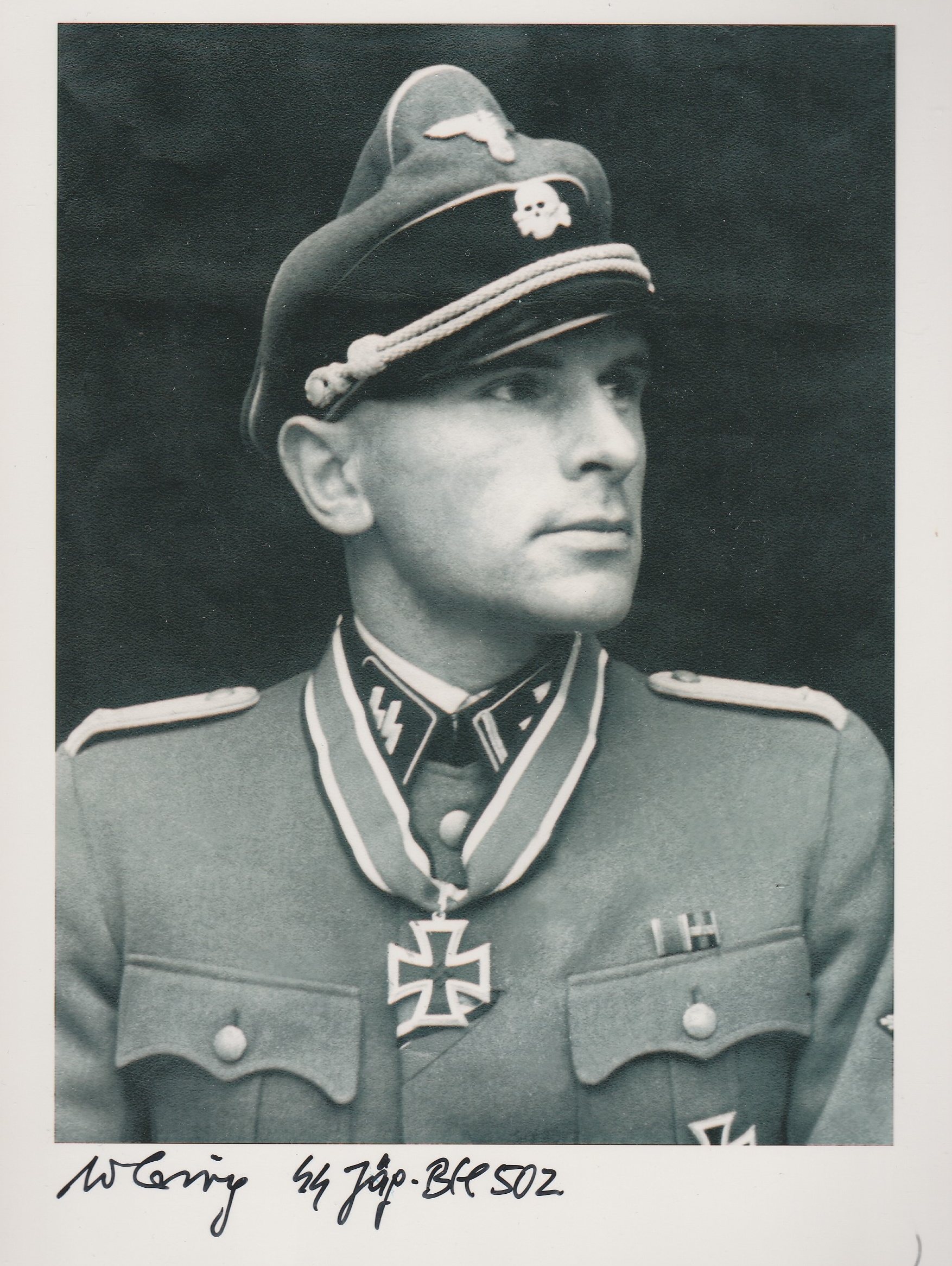|
|

|
~SOLD~GIRG Walter
SS-Obersturmführer der Reserve
Girg, Walter
* August 13th, 1919 (Harburg/Hannover, Germany)
+ July 25th, 2010 (Hilden/North Rhine-Westphalia, Germany)
Knights Cross: October 4th, 1944
As: SS-Obersturmführer der Reserve Zugführer 1. / SS-Jäger-Battalion 502
Girg’s Knight’s Cross recommendation reads as follows…
“SS-Untersturmführer Girg and his special units (consisting of 4 NCOs and 50 men of the 1./SS-Jäger-Bataillon 502) received an order from the Reichsführer SS to try and save ethnic Germans in Romania and bring them over the Romanian border into Hungary. In order to carry out this operation he was subordinated to SS-Obergruppenführer Phleps. The Operation received the codename ‘Landfried’.
When Untersturmführer Girg and his unit made contact with SS-Obergruppenführer Phleps on the 27.08.1944 in Reghin, it was learned that it was no longer possible to carry out the mission due to the strong enemy occupation of the Romanian border. The unit was instead split into three groups (east, middle and west) and received new orders. They were to infiltrate behind Russian lines and reach the Carpathian passes, with some troops being in Romanian uniforms and others in civilian clothing. Upon arriving at their destination they would conduct bridge demolitions and gather reconnaissance on the Russian marching movements.
SS-Untersturmführer Girg led the middle group against the 200 km distant Red Tower Pass. He split his group of 16 into two parts of 8 men each, and he himself took the way to the pass via Schässburg—Hermannstadt. The second group was to reach the destination via a more northern route. However only 2 men would eventually return from this group, the rest were killed by Romanian or Russian soldiers.
SS-Untersturmführer Girg, along with an Oberjunker and 6 men, were able to capture Romanian uniforms after ambushing a Romanian patrol and were then able to get to the Red Tower Pass on several occasions. He made hostile contact several times with Russian patrols, and was forced to constantly evade the enemy while marching in the opposite direction of two Russian Tank Corps. After daily marches of up to 70 km (wherein all weapons including machine-pistols and 60 kg of explosives had to be taken along) he reached the Red Tower Pass. This was already strongly secured by the Russians.
After again making contact with Russian forces he was forced to pull back in the direction of Hermannstadt. From here he was able to precisely gauge the strength of the advancing enemy forces, the value and number of tank concentrations and the location of resistance centres. Enemy combat patrols that wished to arrest what they thought were deserting Romanian soldiers had to be wiped out on several occasions.
During the return march Girg and his group were only able to get through Schässburg by placing themselves at the head of a Russian tank formation so as to avoid contact with the enemy patrols. After continuing north of the city to a point about 30 km from the Hungarian border Girg and his troop unexpectedly encountered Romanian positions. He was arrested along with his men as Romanian deserters. However the Oberjunker was able to flee. Meanwhile Girg and the remaining 6 men were forced to undergo a search. When the enemy discovered their machine-pistols all of them became more or less badly wounded after being smashed with rifle butts. A few of the men received stab wounds from daggers that had been taken from them and were stripped naked.
After a Russian Major appeared he ordered them to be executed at a nearby hill. As all 7 men were being prepared to be killed one of the SS men that had received a stab wound collapsed. Untersturmführer Girg used this opportunity to flee, while the other 6 members of the SS-Jäger-Bataillon 502 died heroes’ deaths. Untersturmführer Girg succeeded in escaping despite being pursued by the greater part of a Romanian-Russian battalion plus horse patrols, although he received a shot through the foot in the process.
Girg knew that the fate of German army formations in this area depended on them receiving his message. Despite his wounded foot and the numerous close encounters with Russian-Romanian blocking positions he was able to reach German Heer elements after a 30+ km foot march. He and his unit had been active behind enemy lines for a total of 10 days. After receiving his report the LVII. Armee-Korps immediately displaced to the west so as to avoid the impending Russian encirclement and the attack that Girg had discovered would take place the next day.
The eastern group of SS men meanwhile had succeeded in blowing 5 bridges around the Predeal Pass and saving a total of 500 officers, NCOs and men from an encircled German Kampfgruppe that was 3000 strong. These 500 troops were brought back over the Hungarian border. This group was also behind the enemy lines for 10 days and brought back valuable reconnaissance results concerning the Russian advance. The western group likewise returned after 14 days of activity behind enemy lines.
The skillful, tactically sound and courageous leadership of SS-Untersturmführer Girg resulted in the acquisition of most valuable intelligence. This in turn ensured that the decisions of the German Heer headquarter units in the area were made correctly and with full appreciation of the enemy situation. His deed was of battle-deciding importance, and thereby is worthy of justifying the award of the Knight’s Cross to the Iron Cross.”
3783rd Award.
Oakleaves: April 1st, 1945
Signed 8" x 6" postwar photo
Price: $0.00
Please contact us before ordering to confirm availability and shipping costs.
Buy now with your credit card
other ways to buy
|
|


